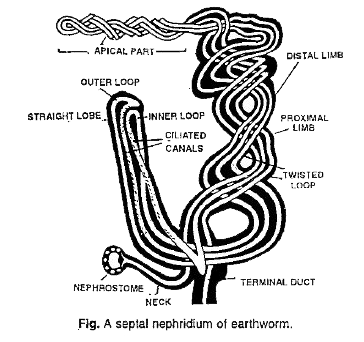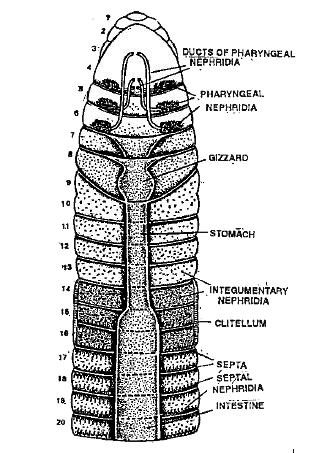Describe the excretory system of earthworm.
Text Solution
Excretory system is the system concerned to pass out metabolic waste products, the earthworm is ammoniotelic when in water and ureotelic when on land.
The main excretory organs in earthworm are nephridia (sing. nephridium). They are coiled tubular and microscopic structures. The nephridia occur in all the segments of earthworm except in the first two segments.
They are of three types :
1. Integumentary Nephridia
2. Pharyngeal Nephridia
3. Septal Nephridia
I. lntegumentary nephridia. They are found scattered on the inner surface of the body wall in each segment except the first two segments and anal segment. In each segment they number from 200 to 250 except in the fourteenth, fifteenth and sixteenth segments ( clitellar region) where their number is about ten times more than that in the other segments. Thus these segments are often called as the "forest of nephridia".
Structure. These nephridia resemble the septal nephridia in general but differ from them in some aspects.
(i) They are the smallest of the three types of nephridia and hardly visible to the naked eye.
(ii) Under the lens they are seen as V shaped structures.
(iii) They have short straight lobe and twisted loop.
(iv) They lack funnel (thus the nephridia are closed internally).
(v) Each nephridium opens directly on the surface of the skin by aperture, nephridiopore. Thus there are present as many nephridipores on the skin as there are integumentary nephridia .
Physiology. They extract excretory products from the coelomic fluid and the blood capillaries But more excretory matter is taken from the coelomic fluid as the integumentary nephridia are seen projecting into the coelomic cavity. The excretory products collecled by the integumentary nephridium are passed out directly by nephridiopore. Such type of nephridia that discharge their contents directly to the outside by nephridiopores are called exo or ectonephric nephridia.
Besides the removal of nitrogeneous waste products, the nephridia play very important role in keeping the water contents constant. 2. Pharyngealnephridia. They occur in three pairs of bunches in the 4th, 5th and 6th segments lying on each side of the alimentary canal. Each bunch has large number of nephridia.
Structure of pharyngeal nephridium. The structure of a pharyngeal is similar to that of the septal nephridium. But they are smaller to that of the septal nephridium and lack nephrostomes. The terminal ducts of pharyngeal nephridia of each bunch join together to form a common terminal duct, which ultimateiy opens into the lumen of the alimentary canal. There are three pairs of common terminal ducts which run forwards. The ducts of the nephridial branches of the sixth segment open into the buccal cavity while the ducts from the nephridial bunches of the fourth and fifth segments open into the pharynx.
3. Septa/ nephridia. They are present attached to the septa behind the fifteenth segment. Number Each septum bears about 40-50 septal nephridia attached to its anterior and posterior surfaces. Thus each coelomic compartment contains 80 to 100 septal nephridia.
Structure of a septa/ nephridium. A typical septal nephrium consists of (i) funnel (ii) the neck (ii) the body of the nephridium.
(i) Funnel. The funtiel is rounded structure with an opening, the nephrostome through which the nephridium communicates with the coelom. The funnel has a hood-like upper lip formed of a large central cell bounded by eight of nine ciliated marginal cells and a lower lip consisting of four or five compact cells. Both the upper and lower lips are separated by the nephrostome (mouth of the funnel).

(ii) Neck. The funnel is followed by a narrow neck which connects the funnel to the proximal limb of the body of the nephridium. A narrow ciliated canal leads from the funnel to the proximal limb.
(iii) Body of nephridium. The body of the nephridium consists ofa large spirally twisted loop and a short straight lobe. The twisted loop is more than twice the length of straight lobe and-consists of distal and a proximal limb and both of which are spirally twisted around each other. The number of twists varies from 9 to 13. The distal limb is connected with the straight lobe while the proximal limb is associated with the neck and the terminal duct. The straight lobe has four ciliated canals in two loops throughout its length. Three ciliated canals from the straight lobe run into the distal limb of the twisted loop while one ciliated canal is continued into the proximal limb of the twisted loop. The cilia of ciliated canals of straight lobe work in opposite directions. At the basal part of each of the two limbs of twisted loop there are present three parallel ciliated canals but in their apical parts two parallel ciliated canals are found. The terminal duct opens into the septal excretory canal of its side. On each septum there is present a pair of septal excretory canals. The two septal excretory canals of each septum open into a pair of supra-intestinal excretory ducts. These ducts lie above the intestine and below the dorsal blood vessel in the mid dorsal line and run from the fifteenth segment upto the posterior end of the body. In every segme11t each supra-intestinal excretory duct opens into the humen of the intestine. Thus there are present as many ductules as are the number of segments. The opening of the ductule is guarded by a sphincter to control the opening and closing of the ductule.
P.hysiology of septa/ nephridia. It is thought that the nitrogenous waste matters come from proteins, purines, pyrimidines and other nitrogenous compounds. In earthworm ammonia is the major nitrogeneous waste. In addition to ammonia, there are present other nllrogeneous wastes such as urea, uric acid, etc .
The nephridial canals are, also lined by glandular epithelium which is very much vascularised by blood capillaries. The cells of the glandular epithelium of the nephridial canals extract nitrogen. The nitrogeneous waste products of coelomic fluid are also taken up by the pephrostomes. These nitrogeneous products pass through the body of the septal nephridium and are finally carried to the terminal ducts.

The nitrogeneous wastes travel in the body of nephridia-the terminal duct-the septal excretory canal-the supraintestinal excretory duct-the ductule-the intestine, and finally passed out through anus along with the faecal matter. There are two supra-intestinal ducts which start from 15th segment and go upto end. They open into intestine by small ductule in each segment.
|
Updated on:21/07/2023
Knowledge Check
- Question 1 - Select One
The excretory organ of earthworm are
ANephridiaBSolenocytesCGreen glandsDKidneys - Question 1 - Select One
Excretory organs of Earthworm are
ANephridiaBGizzardCGreen glandDSolenocytes - Question 1 - Select One
Excretory organs of Earthworm are
ACoelomBFlame cellsCNephridiaDGizzard
Similar Questions
Name the excretory structures of earthworm.
View SolutionName the excretory structures of earthworm.
View SolutionThe excretory organ of earthworm are
View SolutionDefine ureotelism. Name the excretory organs of earthworm.
View SolutionHuman excretory system.
View SolutionWith the help of a labelled diagram, describe human excretory system.
How will you identify acute kidney injury by urine analysis?View SolutionWhat is the excretory system ment for ?
View Solution

